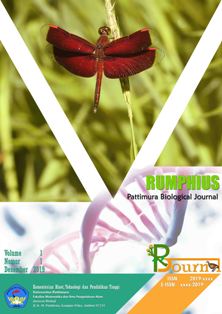Potential of Hotong Flour (Setaria italica (L.) Beauv) from Buru Island in Reducing Blood Cholesterol Levels in Wistar Rats with Diabetes Mellitus
Abstract
Hotong flour (Setaria italica) can be used as a functional food as therapy in the treatment of diabetes mellitus by reduce cholesterol levels in the blood. Hotong is a rice-like food crop that is usually consumed by the people of Buru Island. Hotong seeds have quite high nutritional content, namely containing 11.18% protein, 2.36% fat, 73.36% carbohydrates, 11.78% water, and 1.32% ash. The energy produced per 100 grams of hotong seeds is 359 calories. Hotong plants can be used as an alternative commodity in a carbohydrate-producing food diversification program. This study aims to determine the potential dose of hotong flour in treating diabetes mellitus by reducing cholesterol levels in the blood of rat. This research used 24 wistar rats animals which were divided into 6 groups which were given hotong flour for 21 days and the cholesterol levels were evaluated on the 7th, 14th, and 21st day. Determination of rat blood cholesterol levels using the enzymatic method. Hotong flour can reduce blood sugar levels at doses of 1 g/kg bw and 1.5 g/kg bw in rat that have been made diabetic by examination on days 7, 14 and 21 days.
Downloads
References
Citarrella, R., Chianetta, R., Amodeo, S., Mirarchi, L., Licata, A., Soresi, M., & Giannitrapani, L. (2024). Effectiveness of a Food Supplement Based on Glucomannan, D-Chiro-Inositol, Cinnamomum zeylanicum Blume and Inulin in Patients with Metabolic Syndrome. Nutrients, 16(2), 249. https://doi.org/10.3390/nu16020249
Elkhalifa, A. M., Nazar, M., Ali, S. I., Khursheed, I., Taifa, S., Ahmad Mir, M., & Nabi, S. U. (2024). Novel Therapeutic Agents for Management of Diabetes Mellitus: A Hope for Drug Designing against Diabetes Mellitus. Life, 14(1), 99. https://doi.org/10.3390/life14010099
Fan, G., Zhang, B., Wang, J., Wang, N., Qin, S., Zhao, W., & Zhang, J. (2024). Accurate construction of NIR probe for visualizing HClO fluctuations in type I, type II diabetes and diabetic liver disease assisted by theoretical calculation. Talanta, 268, 125298. https://doi.org/10.1016/j.talanta.2023.125298
Jalali, M., Bahadoran, Z., Mirmiran, P., Azizi, F., & Hosseinpanah, F. (2024). Severity of adipose tissue dysfunction is associated with progression of pre-diabetes to type 2 diabetes: the Tehran Lipid and Glucose Study. BMC Public Health, 24(1), 1-9. https://doi.org/10.1186/s12889-023-17381-1
Kumar, P., Rai, S., & Joshi, A. (2024). Role of functional foods and nutraceuticals for depression, post-traumatic stress disorder, and suicidal behaviors. In Nutraceutical Fruits and Foods for Neurodegenerative Disorders (pp. 101-122). Academic Press. https://doi.org/10.1016/B978-0-443-18951-7.00006-2
Kong, A. P., Chow, E. Y., Luk, A. O., & Chan, J. C. (2024). Other Disorders with Type 1 Diabetes and Atypical Phenotypes. Textbook of Diabetes, 216-224. https://doi.org/10.1002/9781119697473.ch15
Mittendorfer, B., van Vliet, S., Smith, G. I., Petersen, M. C., Patterson, B. W., & Klein, S. (2024). Impaired plasma glucose clearance is a key determinant of fasting hyperglycemia in people with obesity. Obesity. https://doi.org/10.1002/oby.23963
Narayan, K. V., Boyle, J. P., Thompson, T. J., Sorensen, S. W., & Williamson, D. F. (2003). Lifetime risk for diabetes mellitus in the United States. Jama, 290(14), 1884-1890. https://doi.org/10.1001/jama.290.14.1884
Rothberg, A., Lean, M., & Laferrère, B. (2024). Remission of type 2 diabetes: always more questions, but enough answers for action. Diabetologia, 1-9. https://doi.org/10.1007/s00125-023-06069-1
Sari, D. V., Ediyono, S., & Fatmawati, F. (2024). The relationship between smoking behavior and the fulfillment of nutritional needs in the community based on the health belief model theory on blood sugar levels in patients with diabetes mellitus. In Proceedings of Malikussaleh International Conference on Education Social Humanities and Innovation (Miceshi) (Vol. 1, No. 01, pp. 0002-0002).
Su, T., He, Y., Huang, Y., Ye, M., Guo, Q., Xiao, Y., & Luo, X. (2024). Myeloid-derived grancalcin instigates obesity-induced insulin resistance and metabolic inflammation in male mice. Nature Communications, 15(1), 97. https://doi.org/10.1038/s41467-023-43787-x
Unnikrishnan, R., & Mohan, V. (2024). Pancreatic Disease and Diabetes. Textbook of diabetes, 319-329. https://doi.org/10.1002/9781119697473.ch23
Yang, D., Shen, J., Tang, C., Lu, Z., Lu, F., Bie, X., & Zhao, H. (2024). Prevention of high-fat-diet-induced obesity in mice by soluble dietary fiber from fermented and unfermented millet bran. Food Research International, 113974. https://doi.org/10.1016/j.foodres.2024.113974
Yadav, J. P., Singh, A. K., Grishina, M., Pathak, P., Verma, A., Kumar, V., & Patel, D. K. (2024). Insights into the mechanisms of diabetic wounds: pathophysiology, molecular targets, and treatment strategies through conventional and alternative therapies. Inflammopharmacology, 1-80. https://doi.org/10.1007/s10787-023-01407-6
Zhang, H., Sun, Y., Zou, Y., Chen, C., & Wang, S. (2024). Stigmasterol and gastrodin, two major components of banxia-baizhu-tianma decoction, alleviated the excessive phlegm-dampness hypertension by reducing lipid accumulation. Journal of Ethnopharmacology, 319, 117193. https://doi.org/10.1016/j.jep.2023.117193
Copyright (c) 2024 to Authors

This work is licensed under a Creative Commons Attribution-NonCommercial-ShareAlike 4.0 International License.
Authors who propose a manuscript and have it approved for publication know that the manuscript will be registered and become part of the RPBJ. Authors and readers understand that this journal is open and all its contents can be accessed freely, provided that RPBJ is still listed as the source of information. The hope is that this journal can become a vehicle for exchange and scientific knowledge for society and the scientific community, especially in the field of Biology and other branches of science.









